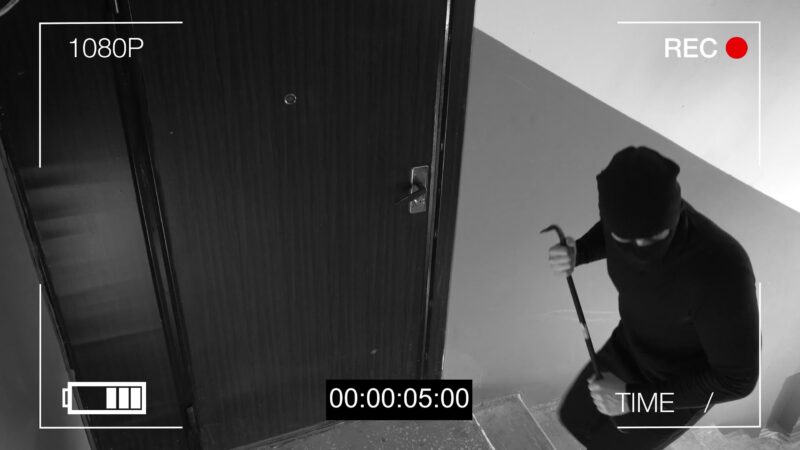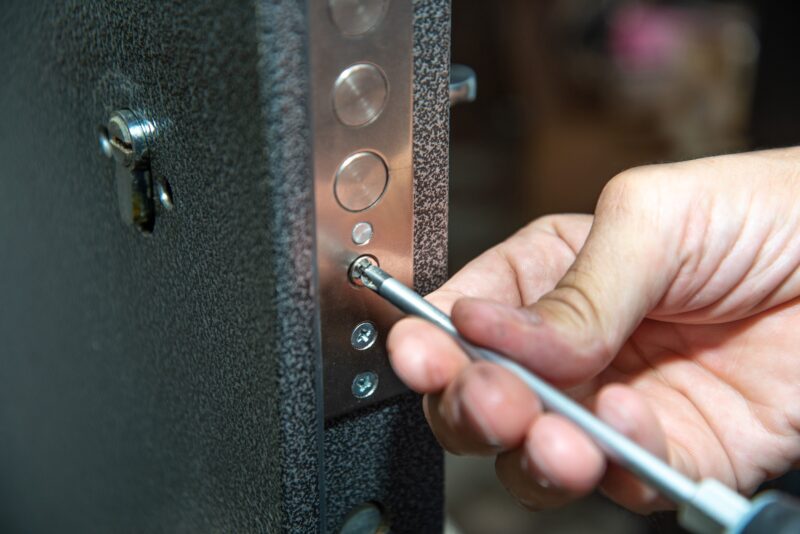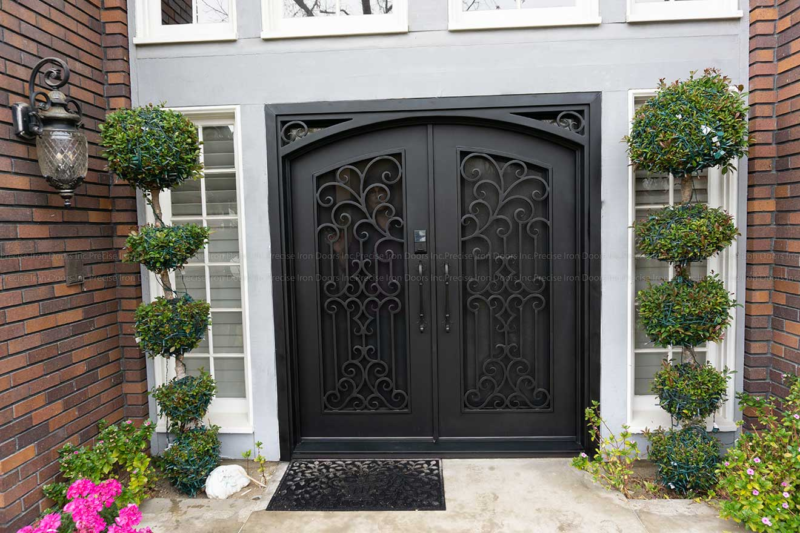How to Increase Front Door Security

Safety is an essential part of a home’s ability to act as a shelter. A home that contains inadequate safety features can hinder a person’s ability to experience relaxation. Residential safety features should keep their guard up so you can let yours down.
Close to seven million property crimes in 2019 is a primary stat that communicates home security importance.1 Most burglars enter a home through the property’s front or back door. Front doors tend to be a primary option for burglars due to their accessibility.
We’re going to cover various ways in which you can increase your home’s front door security. Our goal is to provide numerous reinforcement strategies so you can protect your home with confidence. Let’s dive in.
Upgrade the Quality of Your Door’s Hinges
Door hinges are an essential component of a front door’s infrastructure. Burglars aren’t always able to get past a door’s lock. Manipulating your door hinges is usually a burglar’s backup option to gain entry.
Door hinges directly correspond to your front door’s frame. The dislodgement of your entire front door is a distinct possibility during a door hinge attack.
The two types of door hinges are inward- and outward-facing hinges. Inward-facing hinges provide a higher level of security due to their inaccessibility. Outward-facing hinges are far easier to get past.
You’re not out of luck if your front door contains outward-facing hinges. Switching the direction that your door opens will allow you to have inward hinges.
We understand if you don’t want to hire someone to change your front door’s opening direction. Carrying out this task in a DIY fashion often presents stressful challenges. Adding some small security elements to your door’s hinges is an easier option that produces excellent results.
Minor door hinge security elements you can add include:
- Security studs
- Corrugated pins
- 3-inch set screws
Reinforce Your Front Door
It’s important to plan for the common ways that burglars can get through your front door. Some homeowners choose to invest money in pick-proof deadbolts.
The fact of the matter is that most burglars don’t have pick-locking knowledge. Many burglars can gain entry through body slamming or kicking a certain portion of the door. The result of this force is a split door jamb that leads to home access.
Reinforcing hardware can help you strengthen your door and jamb. The best part about this reinforcing hardware is it’s a relatively low-cost and quick installation.
Reinforcement Phase #1: Install Door Reinforcement Hardware
Begin your hardware reinforcement process with some measurements. The first measurement reflects your front door’s thickness. Next, you can measure the distance between your deadbolt cylinder and the door’s entry handle.
Your initial supply purchase will be a single or double wrap-around door reinforcement kit plate. You’ll then need four 1-½ inch long stainless steel wood screws and a door jamb reinforcement kit. These supplies usually run $120 or less. Hardware stores and home centers regularly carry all of the above materials.
The first step of this reinforcement process is to remove your front door’s entry knob along with its deadbolt cylinder. Taking out the door’s deadbolt cylinder allows you to remove the door’s deadbolt, latch, and short screws. Next, you’ll apply the wrap-around door reinforcement plate before reinstating the door’s latch and deadbolt plates with your long screws.
Reinforcement Phase #2: Install Jamb Reinforcement Hardware
You’ve almost made it to this reinforcement process’s finish line. It’s now time to install jamb reinforcement hardware. Initiate this stage by extending the door’s deadbolt a bit before closing the door. Moving the door’s deadbolt out will allow you to mark the deadbolt’s middle on your door jamb with a pencil before doing the same with the door’s latch.
You’ll need to mark the latch since you’ll be temporarily removing it along with weather stripping and strike plates. The only weather stripping that should remain is the stripping that’s linked to the doorstop. You’ll be able to attach the reinforcement plate you bought by pre-drilling a few separate mounting holes before adding screws.
You can install the screws by hand after validating the reinforcement plate’s alignment. Overtightening these screws is something to avoid.
Starting this reinforcement process by removing the deadbolt cylinder helps you remove the deadbolt before adding the remaining screws. The last step is to replace each of the hinge’s two screws with your longer 1½-inch long stainless steel wood screws. Hiring someone to complete this reinforcement process is always an option.
Having an understanding of the DIY front door reinforcement process helps you initiate each stage with more confidence. Front door reinforcement is a worthwhile process, no matter which route you decide to take.
Upgrade Your Front Door’s Lock

Locking your front door may seem like an obvious way to increase your home’s security. The problem is that some homeowners get in the habit of not locking their front door when their surroundings appear to be safe. An automatic door locking system serves as a solution for this problem. You can have peace of mind knowing that your door will lock regardless of whether you locked it yourself.
Keyless door locks are a reliable way to upgrade the security of your front door. These devices are easy to use and install. Popular keyless door lock models can include a button or touchscreen pads that grant home access after you enter the pre-set code.
Utilize Interior Securing Hardware
Interior security hardware is straightforward in its functionality. There are different types of interior security hardware devices. One example is an obstruction device that goes from the doorknob to the interior’s ground.
This steep reinforced angle is an easy way to elevate your front door’s security. It’s essential to recognize that typical interior securing hardware like chain locks and flush door latch bolts aren’t as effective.
There are a couple of common complaints associated with interior securing hardware. The devices we mentioned that go from a door’s knob down to the floor at a steep angle aren’t aesthetically pleasing. A second complaint related to interior securing hardware is that you won’t be able to get inside unless someone is in the house to give you entry. This dilemma is exceptionally inconvenient for people living alone.
Don’t Cover Up Entryways
Burglars tend to avoid visible front entryways. Intruders need to take time to manipulate your front door’s security components. Performing this task in an open-view entryway can easily lead to a burglar getting caught.
Shrubs and fences are two examples of property elements that can obstruct a front door view. Proper lighting is helpful but won’t come in handy during a power outage event. Motion sensor lights act can signal homeowners while simultaneously increasing property visibility. Balancing obstacles like a property fence with a clear front entry view is your best bet.
Install a Security Camera
Security cameras stand as one of the easiest ways to monitor your front door. Traditional security recording cameras aren’t your only option. Smart doorbells can initiate a video recording when a person presses the button. Nest is an example of a company that manufactures easy-to-install property cameras.
The goal of video monitoring is to provide an alert when suspicious activity is occurring. It’s then up to you to take the necessary action to follow up on an alert. The least you can do is use the surveillance footage as a resource to help locate a criminal. Many people use an alarm system in tandem with surveillance devices.
Strengthen Glass Surfaces
Glass front door surfaces pose a significant threat to your front door’s security. You want to remove an intruder’s ability to break parts of the door’s glass to reach inside then and unlock the door. One option is to own a front door with glass components that are a safe distance from the door’s handle or thumb turns.
Barring glass portions of your front door can provide you with a substantial level of protection. Some people choose to skip over this option since they don’t admire the aesthetics that bars create. Barred glass doesn’t have to be unattractive. Irons doors are an example of a popular door variety that can utilize bar protection through aesthetically delightful designs.
Precise Iron Doors Makes Safety a Standard Offering

Precise Iron Doors is here to offer you entry door options that are protective and visually appealing. The durability that wrought iron doors contain can easily deter a potential intruder. Add high-quality locks to a wrought iron door, and you’ll be in the clear.
You won’t have to worry about exterior door lock-picking, either. The high-strength iron enclosure that wrought iron doors provide will make it virtually impossible for a burglar to manipulate your lock.
Contact Precise Iron Doors today at 844-830-6707 to take a step toward upgrading your front door’s security and appearance.
